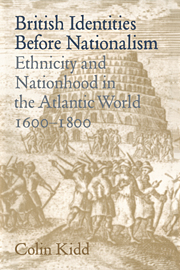Book contents
- Frontmatter
- Contents
- Acknowledgements
- Note
- List of abbreviations
- 1 Introduction
- Part I Theological contexts
- Part II The three kingdoms
- 4 Whose ancient constitution? Ethnicity and the English past, 1600–1800
- 5 Britons, Saxons and the Anglican quest for legitimacy
- 6 The Gaelic dilemma in early modern Scottish political culture
- 7 The weave of Irish identities, 1600–1790
- Part III Points of contact
- Index
6 - The Gaelic dilemma in early modern Scottish political culture
Published online by Cambridge University Press: 06 July 2009
- Frontmatter
- Contents
- Acknowledgements
- Note
- List of abbreviations
- 1 Introduction
- Part I Theological contexts
- Part II The three kingdoms
- 4 Whose ancient constitution? Ethnicity and the English past, 1600–1800
- 5 Britons, Saxons and the Anglican quest for legitimacy
- 6 The Gaelic dilemma in early modern Scottish political culture
- 7 The weave of Irish identities, 1600–1790
- Part III Points of contact
- Index
Summary
In early modern Scotland Gaeldom defined the historic essence of nationhood, yet also represented an alien otherness. The history, much of it mythical, of the Gaelic Scots of the ancient west Highland kingdom of Dalriada stood proxy for the early history of the whole Scottish nation. This matter of Dalriada provided precedents for Scotland's ancient constitutions in church and state, and formed the basis of Scotland's claims to independence from English suzerainty. However, the early modern period also witnessed a conscious design on the part of Lowland elites to extirpate contemporary Gaeldom, and to assimilate the Gaelic Highlanders to Lowland standards and values in every sphere of life: culture, public order, law, religion and language. This intolerance of Gaelic ‘difference’ transcended political and ecclesiastical divisions, which rested, ironically, on arguments drawn from the Dalriadic past.
The making of early modern Scottish identity
The origins of this situation lie deep in the medieval Scottish past. The nation of Scotland had its origins in the incorporation of the Scotic and Pictish gentes in the eighth and ninth centuries. The kingdom of Alba which united Scots and Picts had its centre of gravity in the Pictish kingdom of Fortriu, but the importance of the Gaelic Columban church in the Christianising of Scotland may have contributed to the ascendancy of Gaelic language and culture in the new nation and to the complete disappearance of Pictish.
- Type
- Chapter
- Information
- British Identities before NationalismEthnicity and Nationhood in the Atlantic World, 1600–1800, pp. 123 - 145Publisher: Cambridge University PressPrint publication year: 1999



